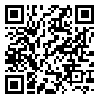Volume 1, Issue 1 (Winter 2018)
Func Disabil J 2018, 1(1): 68-73 |
Back to browse issues page
Download citation:
BibTeX | RIS | EndNote | Medlars | ProCite | Reference Manager | RefWorks
Send citation to:



BibTeX | RIS | EndNote | Medlars | ProCite | Reference Manager | RefWorks
Send citation to:
Jalaei B, Normani Zakaria M. The Results of ABR in a Child with Noonan Syndrome: Necessity of Renewing
the Evaluation Protocols of Syndromes. Func Disabil J 2018; 1 (1) :68-73
URL: http://fdj.iums.ac.ir/article-1-31-en.html
URL: http://fdj.iums.ac.ir/article-1-31-en.html
1- Audiology Group, School of Rehabilitation Sciences, Iran University of Medical Sciences, Tehran, Iran
2- Audiology Program, School of Health Sciences, University of Sains, Kelantan, Malaysia
2- Audiology Program, School of Health Sciences, University of Sains, Kelantan, Malaysia
Abstract: (2726 Views)
55 years after discovering NS, there was not even one publication regarding the use of auditory electrophysiological tests for analyzing the central auditory nervous system in NS patients. This is an attempt to attract attention of scientists and clinicians in using AEPs for evaluating the function of CANS in NS. Readers can find a report about the results of audiological tests and auditory brainstem response (ABR) findings in a 5-year old Malay boy with NS. It should be noted that he could only produce a few meaningful words. The results of audiological tests showed bilateral mild conductive hearing loss at low frequencies. ABR recordings showed good waveform morphology but the results were atypical. That is, absolute latency of wave V was normal but interpeak latencies of waves I-V, I-II, II-III were prolonged. Conversely, interpeak latency of waves III-V was abnormally shorter.
Abnormal ABR results are possibly due to an abnormal anatomical condition or abnormal function of brainstem and might cause speech delay.
Abnormal ABR results are possibly due to an abnormal anatomical condition or abnormal function of brainstem and might cause speech delay.
Type of Study: Case Report |
Subject:
Audiology
Received: 2017/03/28 | Accepted: 2017/06/5 | Published: 2017/10/29
Received: 2017/03/28 | Accepted: 2017/06/5 | Published: 2017/10/29
References
1. Burgt, I.V.D. (2007) Noonan Syndrome. Orphanet Journal of Rare Diseases, 2(4). [PubMed]
2. Cremers, C.W., Van der Burgt, C.J. (1992) Hearing loss in Noonan syndrome. Int J Pediatr Otorhinolaryngol, 23(1), 81- 84. [DOI]
3. Hall, J. (2015) eHandbook of auditory evoked responses. Boston Mass: Pearson.
4. Heller, R.H. (1965) The Turner phenotype in the male. The journal of Pediatrics. 66(1), 48-63. [DOI]
5. Kao, C.P. (1999) Evaluation and management of the child with speech delay. Am Fam Physician. 59(11) :3121-3128. [PubMed]
6. Matas, C.G., Leite, R.A., Goncalves, I.C., Neves, I.F. (2005) Brainstem Auditory Evoked Potential in Individuals with Conductive and Sensorineural Hearing Losses. Int Arch Otorhinolaryngol. 9 (4), 337-347.
7. Mendez, H.M.M., Optiz, J.M. (1985) Noonan Syndrome: a review. Am J Med Genet. 21(3), 493- 506. [DOI] [PubMed]
8. Miura, M., Sando, I., Orita, Y., Hirsch, B.E. (2001) Temporal bone histopathological study of Noonan syndrome. Int Journal of Pediatric Otorhinolaryngology. 60, 73-82. [DOI]
9. Noonan, J.A. & O'Conner. (1996) Noonan syndrome: a clinical description emphasizing the cardiac findings. Acta Paediatrica Japonica, 38, 76–83. [DOI] [PubMed]
10. Nora, J.J., Nora, A.H., Sinha, A.K. et al. (1974) The Ullrich-Noonan syndrome (Turner phenotype). Am J Dis Child. 127(1), 48-55. [DOI]
11. Romano, A.A., Allanson, J.E., Dahlgren, J. et al. (2010) Noonan Syndrome: Clinical Features, Diagnosis and Management Guidelines. Amer Acad Paediatrics, 126 (4), 746-759. [DOI]
12. Sharland, M., Burch, M., McKenna, W.M., Patton, M.A. (1992) A clinical study of Noonan Syndrome. Arch DisChild, 67, 178-183. [DOI]







